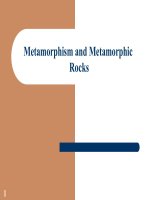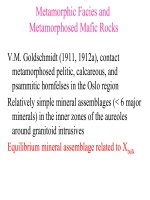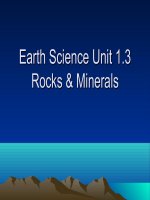METAMORPHIC ROCKS (1)
Bạn đang xem bản rút gọn của tài liệu. Xem và tải ngay bản đầy đủ của tài liệu tại đây (4.12 MB, 18 trang )
Metamorphic Rocks
Metamorphic Rocks
Metamorphic rocks are produced from preexisting igneous,
sedimentary, or from other metamorphic rocks. Every metamorphic
rock has a parent rock – the rock from which it was formed.
Metamorphism, which means to “change form,” is a process that leads
to changes in the mineralogy, texture, and sometimes the chemical
composition of rocks. Factors that might cause a rock to alter from one
form to another includes changes in temperature, pressure (stress),
and the introduction to chemically active fluids.
Metamorphism often progresses incrementally, from slight changes
(low-grade metamorphism) to substantial changes (high-grade
metamorphism). An example of low-grade would be shale turning into
slate when put under pressure (stress). In high-grade changes, slight
melting may occur, as well as folds or obliteration of fossils or vesicles
in the parent rock.
Examples of
Metamorphic Rocks
Gneiss
Slate
Schist
Marble
Quartzite
Phyllite
What Drives Metamorphism?
The agents of metamorphism include heat, pressure (stress), and
chemically active fluids. During metamorphism, rocks may be
subjected to all three metamorphic agents simultaneously.
Heat is the most important of metamorphism because it provides the
energy to drive chemical reactions that result in the recrystallization
of existing materials and/or the formation of new materials.
Earth’s internal
heat comes
mainly from
radioactive
decay within the
Earth’s interior.
What Drives Metamorphism?
Pressure, like temperature, increases as you get deeper into the
Earth. Buried rocks are subjected to this pressure, called confining
pressure, which causes the spaces between mineral grains to close,
producing a more compact rock having a greater density. This
pressure may ultimately cause minerals to recrystallize into new
minerals that a display a more compact form.
Unlike confining pressure, which
“squeezes” rock equally in all
directions (and does not fold or
deform them), differential stress,
where forces pushing on the rocks
are unequal, can create folds and
deformation. This is especially
prominent at convergent plate
boundaries.
Metamorphic Rock Textures
Texture is used to describe the size,
shape, and arrangement of grains
within a rock.
Most igneous and sedimentary rocks
consist of mineral grains that have a
random orientation. By contrast,
deformed metamorphic rocks that
contain platy minerals (micas) and/or
elongated minerals (amphiboles)
typically display some kind of preferred
orientation in which the mineral grains
exhibit a parallel or specific alignment.
This preferred orientation of a rock’s
minerals is called a foliated texture.
Mica Schist
Gedrite
Examples of Foliated Textures
Various types of foliation exist, depending largely upon the grade of
metamorphism and the mineralogy of the parent rock. We’ll look at
three main types of foliation: rock or slaty cleavage; schistosity; and
gneissic texture.
Rock or Slaty Cleavage:
This type of foliated texture
describes a rock’s tendency
to break or cleave along a
specific crystal plane. Slate
is a rock with excellent rock
cleavage, as it breaks in flat
slabs.
Examples of Foliated Textures
Schistosity: This type of
foliated texture describes a
rock created with large,
platy minerals (such as mica
and chlorite) that have
grown large enough to be
seen by the unaided eye.
In addition to platy
minerals, schist often
contains deformed quartz
and feldspar grains that
appear as flat, or lensshaped, grains hidden
among the mica grains.
Examples of Foliated Textures
Gneissic Texture: During
high-grade metamorphism,
ion migrations can result in
the segregation of minerals.
Although foliated, gneisses
will not usually split as
easily as slates and schists.
Gneisses that do cleave tend
to break parallel to their
foliation and expose micarich surfaces that resemble
schist.
Foliated Metamorphic Rocks
Gneiss
Slate
Schist
Phyllite
Other Metamorphic Textures
Not all metamorphic rocks exhibit a foliated texture. Those that do not
are referred to as nonfoliated. Nonfoliated textures usually form in
environments where parent rocks are composed of minerals that
exhibit equidimensional crystals, such as quartz or calcite.
Another texture common to
metamorphic rocks consists of
particularly large grains, called
porphyroblasts, that are
surrounded by a fine-grained
matrix of other minerals.
Porphyroblastic textures develop
in a wide range of environments
and result in very large specimens
of certain minerals, such as
garnets.
Nonfoliated Metamorphic Rocks
Marble
Quartzite
The exterior of the Taj Mahal is constructed mainly of the
metamorphic rock marble.
Metamorphic Environments
Hydrothermal metamorphism occurs when hot fluids circulate
through fissures and cracks that develop in rock. This hot fluid
chemically alters rocks and is closely related to igneous activity.
Metamorphic Environments
There are a number of environments in which metamorphism occurs.
Most are in the vicinity of plate margins, and many are associated
with igneous activity.
Contact or thermal
metamorphism
occurs when rocks
immediately
surrounding a molten
igneous body are
“baked” and therefore
altered from their
original state.
Metamorphic Environments
Regional metamorphism occurs where rocks are squeezed
between two converging lithospheric plates during mountain
building.
The typical transition in mineralology that results from progressive
metamorphism of shale.









